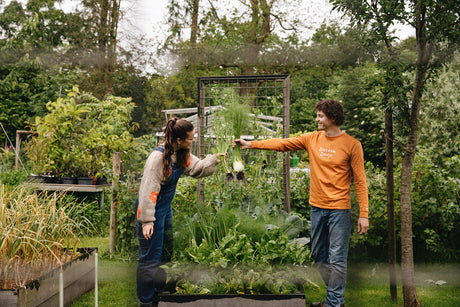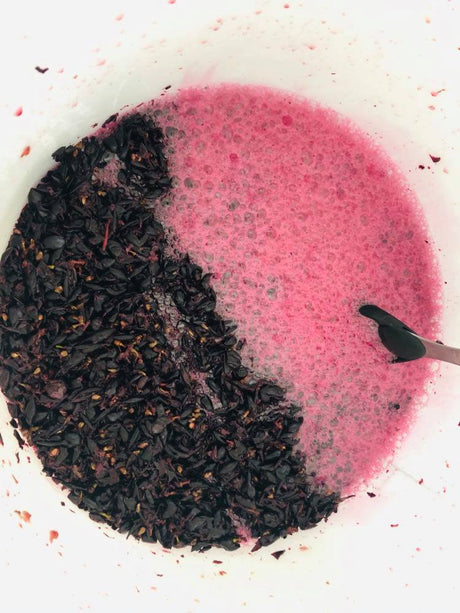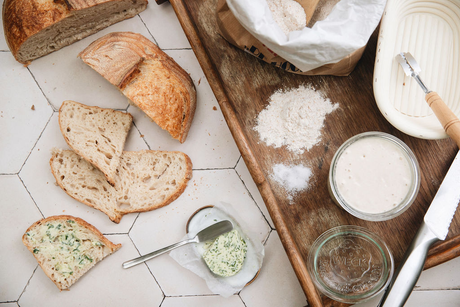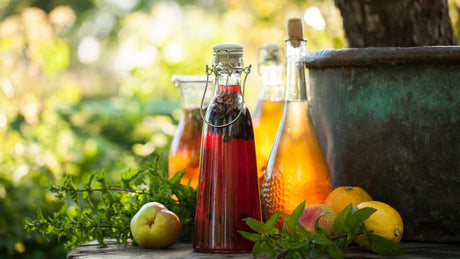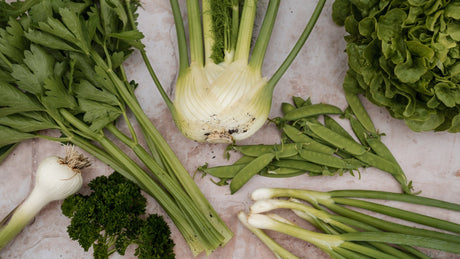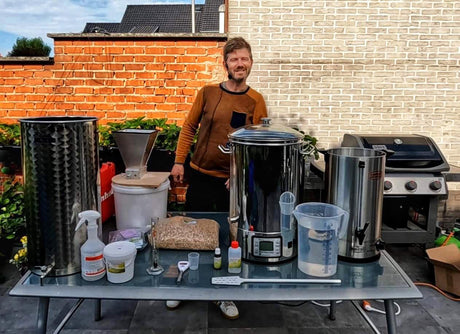Planting a fruit tree - low trunk, columnar or patio tree - 10 tips
'An apple a day keeps the doctor away', especially if you grew it yourself
We've been eating a lot of strawberries and currants from the vegetable garden lately, and apples and pears will follow soon. In our chicken run, we have two low-stem fruit trees : an apple tree and a pear tree . Perfect, since my vegetable garden isn't very big. Growing fruit isn't actually as difficult as you might think. How exactly do you do it? In this article, I'll explain everything. Planting a fruit tree will be child's play. Growing fruit doesn't just ensure a good harvest. In spring, you can enjoy the beautiful blooms and the bees buzzing from one blossom to the next. Here we go!
The different types of fruit trees
TIP 1: Choose the right type of fruit tree to plant based on the size of your vegetable garden
Anyone can grow fruit. You don't need a huge vegetable garden. The most important thing is to choose a fruit tree that fits your garden. There are five different types of fruit trees available. To get an idea of how big your fruit tree will grow, look at the terms patio tree, columnar tree, low-stem, half-stem, and high-stem. These terms refer to the type of rootstock used for grafting. Just like grapes, fruit trees are grafted at the nursery because it's known that ungrafted fruit trees often root less well, resulting in weaker growth and lower yields. Just like us, you naturally want strong fruit trees that bear kilos of fruit. That's why we only offer grafted fruit trees in our webshop. I'll now explain exactly what the terms patio tree, columnar tree, low-stem, half-stem, and high-stem mean.

Mini plum tree
Patio trees
Patio trees are also called ballerina or mini fruit trees. This is because, guess what?, they stay very small. They grow to about 1.5 meters tall. Perfect for growing in pots (for example, on your patio or balcony) and require little maintenance. Keep them small by pruning occasionally. This tree may be small, but the fruit grows to the same size as a standard fruit tree. Do make sure you give your fruit trees enough water. If your tree has been dry, it will drop its fruit first. What a shame! If you choose to plant your fruit tree in the ground, water it mainly in the summer or on hot days during the year of planting. Later, I'll share tips on how and where to plant a tree.

Columnar apple trees grow vertically and produce few side branches
Columnar trees
A columnar tree is a fruit tree that grows vertically and produces very few side branches. Therefore, a columnar tree takes up very little space. It's ideal for growing fruit in smaller areas or in (40-liter) pots. Because a columnar tree produces few to no side branches, pruning is unnecessary. Do you have an empty spot next to your garden shed? This type of fruit tree is ideal for making the most of small spaces.

Low-stemmed Conference pear tree
Low-stem fruit trees
Low-stemmed means the tree is grafted onto a slow-growing rootstock, allowing the trees to bear fruit faster and grow smaller. The advantages of this are that they're suitable for smaller (vegetable) gardens and allow you to grow more varieties in the same space. A low-stemmed fruit tree grows to about 2.5 to 4 meters tall, so leave 2.5 to 4 meters between each low-stemmed tree. This is convenient because it allows you to harvest easily, safely, and without a long ladder. Low-stemmed fruit trees don't take up much space. Ideal for anyone (myself included ? ) who finds their vegetable garden too small for everything they want to grow. Low-stemmed fruit trees live for about 3 to 40 years. We offer a wide variety of fruit trees in our online store. Be sure to take a look; there are some really nice varieties. Choose the fruit you like. Just because these fruit trees are low-stemmed doesn't mean you'll have a smaller harvest. You can expect a harvest of between 5 and 20 kg of fruit. Ideal for growing lots of fruit even though you may have a small vegetable garden.
Half-stem fruit trees
Half-standard fruit trees, like low-standard fruit trees, are grafted onto a slow-growing rootstock. Half-standard fruit trees grow to about 5 meters tall, so you should also allow 5 meters of planting space between them. This type of fruit tree requires a bit more space than low-standard fruit trees. A half-standard fruit tree can easily yield 50 kg of fruit. They can live for 60 to 100 years.
High-stem fruit trees
Standard fruit trees are, as their name suggests, the tallest variety. They can reach 7 to 8 meters tall. The recommended planting distance is again based on the estimated height: 7 to 8 meters. You'll need a fairly large garden (or orchard) for these fruit trees. The rootstock of a standard fruit tree is at least 1.7 meters tall, so we don't offer this type of fruit tree.
Planting fruit trees
And now for the real work. After figuring out which type of fruit trees are suitable for your vegetable garden and choosing the fruit variety(s) you'll grow, you'll plant them. I'll explain the best way to do that.
TIP 2: Keep in mind that fruit trees grow old
When planting fruit trees, you need to consider the future a bit more than when planning your vegetable garden. Most vegetables only last one or two seasons in your vegetable garden, while most fruit trees can live 30, 40, and even 100 years. The lifespan of fruit trees also depends somewhat on care and size. The older a tree can get, the larger it will become.
TIP 3: Want lots of fruit? Plant more than one fruit tree of the same variety to increase your harvest.

By allowing cross-pollination to take place, you play it safe
What about cross-pollination? Cross-pollination of fruit trees occurs during flowering, when pollen is transferred from the male part of the flower to the female part. This transfer of pollen from one fruit tree to another is called cross-pollination. Therefore, it's a good idea to plant two different types of apple trees, for example, so that insects can find enough blossoms and transfer the pollen from one tree to the other. Cross-pollination can only occur between the same type of fruit tree; for example, a pear tree cannot pollinate a cherry tree. We offer a number of classic and specialty varieties for each type of fruit tree. For example, we have 17 apple varieties available in our webshop :)

Classic apple varieties (left to right): Jonagold, Elstar, Rode Boskoop, Braeburn, Granny Smith, Golden Delicious.

Special apple tree varieties (left to right): Red Love Lubera, Sparkling Lubera, Bramley's Seedling, Cox's Orange Pippin, Discovery, Gala, Gloster, Gravenstein, Ingrid Marie, James Grieve, Summerred.
When is the best time to plant your fruit tree?
TIP 4: You can actually plant fruit trees almost all year round
The fruit trees we offer in our webshop are delivered in pots. They have already established a root system, so you can plant them virtually year-round. The best planting time is autumn. It's not as hot then, there's still some rain, and the fruit trees still have plenty of time to establish roots . This way, they can enter the winter with a strong root system and sprout their first shoots in spring, perhaps bearing their first fruit a few months later. But be careful! Never plant fruit trees during frost. Sometimes fruit trees are also offered bare-root. We at Moestuinweetjes don't do that. For the simple reason that the roots would quickly dry out in transit, giving your tree a bad start.
How do you plant a fruit tree?
Soil preparation for planting fruit trees in open ground
TIP 5: Provide loose soil that contains sufficient nutrients
Regardless of which type of fruit tree you choose (mini fruit tree, columnar tree, dwarf, half-standard, or standard), the planting procedure remains the same. Loosen the soil well, using a spade , and ensure good soil structure by adding compost , lava grit , basalt flour (and bentonite if growing on sandy soil). Provide sufficient nutrition with berry fertilizer pellets . Dig a hole about half a meter in diameter and make a planting hole slightly deeper than your planting pot. Collect the soil in a bucket and mix in a third of it with coconut fiber or compost . This will improve the soil structure, help retain moisture, and make it easier for the tree to root. Always plant your tree at the same depth as it was at the grower's (the depth of the pot).
Planting distance
The spacing between fruit trees is the same as the estimated size of your fruit tree. If you choose patio fruit trees, maintain a distance of 1 to 1.5 meters, for low-stemmed fruit trees , 2.5 to 4 meters, for half-stemmed fruit trees, maintain a distance of 5 meters, and so on. Columnar fruit trees are an exception; you can plant them closer together. Because columnar trees hardly produce any side branches, a planting distance of 0.5 meters is sufficient.
Support your fruit tree
After you've planted your fruit tree, it's important to support it. I use a chestnut stake and a tree tie for this. Position the stake facing southwest of your fruit tree to prevent the tree from constantly blowing against the stake, preventing abrasions and tearing off the new, fine root hairs underground. Drive the stake about 40 cm into the ground. Then, secure your fruit tree about 30-40 cm high with a tree tie .
TIP 6: You can also grow fruit trees in pots
There's nothing better than fruit from your own garden. But what if you live in an apartment or your garden isn't very large? That doesn't mean you can't grow fruit. Patio or mini fruit trees are perfectly fine to grow in pots. You can also grow low-stem fruit trees in pots. Make sure your pot is large enough; about 40 liters is sufficient. Growing in pots does require a little extra care. If you let the potting soil dry out, your fruit tree will drop its blossoms or fruit. And then, of course, it's game over. Therefore, choose a well-structured potting soil . To prevent your soil from drying out too quickly, you can add about 3 cm of hydro pebbles to the bottom and create your own mixture to fill your pot. Mix 1/3 coconut fiber with 2/3 potting soil . This ensures that the water is retained longer. A second point of attention is nutrition, which runs out about three months after planting. This "problem" is also easily addressed. Sprinkle some soft fruit fertilizer into your pot every three months (but not between October and March, when your tree is dormant). The fertilizer will gradually dissolve when you water it. This way, your tree always gets what it needs to grow well.
Caring for fruit trees
By now, your tree has grown well and you may have already harvested your first apples or cherries. How can you ensure you can enjoy your fruit tree for years to come?
TIP 8: Give your fruit trees something tasty from time to time
To enjoy delicious fruit, your fruit tree needs nutrient-rich soil. Give your fruit tree some soft fruit and strawberry fertilizer every three months. This balanced fertilizer contains everything your fruit tree needs. Do not fertilize when your fruit tree is dormant (from October to March).
How do you prune fruit trees?
Fruit trees are best pruned twice a year, with the exception of patio trees and columnar trees. Patio trees are pruned to maintain their small shape. Columnar trees, on the other hand, are not pruned at all, unless a large side branch develops, in which case you can cut it away.
Tip 9: It is best to prune low-stemmed fruit trees twice a year
Pruning your fruit trees ensures that energy is directed to the right place in your tree, stimulating growth. Fruit always grows on framework branches. A framework branch is a base branch that grows off the main trunk. Make sure you have about five or six framework branches. These will produce side branches that will bear your fruit. There are two types of pruning: summer pruning and winter pruning. Always prune just above a bud, so your fruit tree can sprout again quickly. Look for an outer bud, which is a bud on the outside of the branch. This will ensure that your branch sprouts along the outside, which is exactly what you need.

Winter pruning: look at your fruit trees from a distance
Winter pruning (between December and mid-February)
Your fruit tree grew considerably over the summer. It developed beautiful branches that will bear your first or new fruits next year. Look at your fruit tree from a distance. Do you see branches growing quickly and straight up? Then it's a water sucker. You can prune these branches back heavily during winter pruning, leaving one or two buds per branch. Do you see branches growing inward? You can prune those away as well. These make your fruit tree less airy and reduce the amount of sun that reaches your leaves and fruits.
Summer pruning (between mid-April and September)
In summer, you prune your fruit trees because that's when the energy is directed towards your fruit. Pruning your fruit tree will help it grow and ripen better. As you know, a fruit tree, like all other plants in your vegetable garden, photosynthesizes. Therefore, don't remove all the leaves. Nut trees and drupe-bearing fruit trees (peach, plum, apricot, and cherry) are an exception; prune these only in December and January. Otherwise, they will lose too much sap and bleed to death.
Use sturdy and clean pruning equipment
To ensure smooth pruning, it's best to use good-quality pruning shears. If you have larger branches to prune, use pruning shears.
Tip 10: Harvest and enjoy fruit!
Did you know we have a free vegetable garden planner app? Touch, smell, and taste to know if your fruit is ready to pick. A bowl of freshly picked cherries in front of the TV in the evening—what more could you ask for? You can find specific harvesting tips for each fruit type in our free app "Vegetable Garden Planner." Download the app from the App Store or Play Store or access it via this link .
Finally
Hopefully, these tips have convinced you to start growing fruit in your own garden. With these tips, you're sure to succeed. Enjoy the beautiful flowering season in spring and the delicious fruits in summer or autumn. If you found this article helpful and are considering growing your own fruit, consider purchasing your vegetable garden supplies from our online store . We're always ready to provide high-quality products and helpful explanations (by phone, chat, or email); your garden success is our priority. Photos of your vegetable or fruit garden are always welcome at support@plukkers.com.
Kind regards, Sarah


